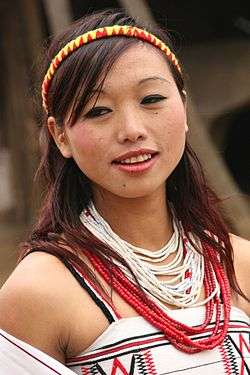Bhil people
Bhils or Bheels are an Indo-Aryan speaking ethnic group in West India. They speak the Bhil languages, a subgroup of the Western Zone of the Indo-Aryan languages. As of 2013, Bhils were the largest tribal group in India.[3]
 Bhil child in Madhya Pradesh | |
| Total population | |
|---|---|
| c. 16 million[1] | |
| Regions with significant populations | |
| 16,908,907[2][1] | |
| Madhya Pradesh | 5,993,921[1] |
| Gujarat | 4,215,603[1] |
| Rajasthan | 4,100,264[1] |
| Maharastra | 2,588,658[1] |
| Karnataka | 6,204[1] |
| Tripura | 3,105[1] |
| Andhra Pradesh | 604[1] |
| Chhattisgarh | 547[1] |
| 474,000 | |
| Languages | |
| Bhil languages •Marathi• Gujarati • Sindhi •Hindi | |
| Religion | |
| Hinduism • Islam •Christian | |
| Related ethnic groups | |
| Indo-Aryan peoples, Bhel (tribe), Warli, Halba | |
Bhils are listed as indigenous people of the states of Gujarat, Madhya Pradesh, Chhattisgarh, Maharashtra and Rajasthan—all in the western Deccan regions and central India—as well as in Tripura in far-eastern India, on the border with Bangladesh. Bhils are divided into a number of endogamous territorial divisions, which in turn have a number of clans and lineages. Most Bhils now speak the language of the region they reside in, such as Marathi, Gujarati or a Hindustani dialect.
History
The Bhils of what is now the state of Gujurat rebelled on several occasions during the British colonial era, notably in 1846, 1857-58 and 1868.[4]
The Bhils are inhabitants of Dhar, Jhabua, Khargone and Ratlam districts of Madhya Pradesh. A large number of Bhils live in the neighbouring States of Maharashtra, Gujarat and Rajasthan. They constitute the third largest tribe of India; the first two being Gonds and Santhals [5]
Present circumstances
The Bhil are classified as a Scheduled Tribe in Andhra Pradesh, Chhattisgarh, Gujarat, Karnataka, Madhya Pradesh, Maharashtra, Rajasthan and Tripura under the Indian government's reservation program of positive discrimination.[2]
Sub-divisions
The Bhil are divided into a number of endogamous territorial divisions, which in turn have a number of clans and lineages. In Rajasthan, they exist as Meena, Bhil Garasia, Dholi Bhil, Dungri Bhil, Dungri Garasia, Mewasi Bhil, Rawal Bhil, Tadvi Bhil, Bhagalia, Bhilala, Pawra, Vasava and Vasave.[6][lower-alpha 1]
Madhya Pradesh has the largest Tribal population of all the states. Agariya, Andh, Baiga, Bhaina, Bharia, Bhumia, Bhuinhar, Bhumiya, Bharia, Pando, Bhattra, Bhil, Bhilala, Barela, Patelia, Bhil, Mina. Gond, Arakh, Arrakh, Agaria,Asur, Badi Maria, Bada Maria, Bhatola, Bhimma, Bhuta, Koilabuta, Koliabhuti, Bhar, Bisonhorn Maria, Chota Maria, Dandami Maria, Dhuru,Dhurwa, Dhoba, Dhulia, Dorla, Gaiki, Gatta, Gatti, Gaita, Gond, Gowari, Hill Maria, Kandra, Karariya, Kararia, Karari,Karria, Kalanga, Khatola, Koitar, koya, Khirwar, khirwara, kucha, Maria, Madia, Maria, Mana, Mannewar, Moghya, Mogia Monghya, Mudia, Muria [7][8]
Language
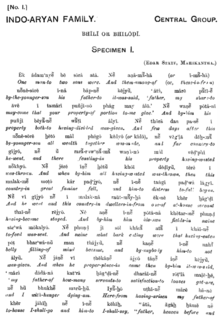
The language commonly spoken by Bhils throughout their geographic distribution is Bhili.[9] Bhili has about up to 36 identified dialects and pronunciation differs by region.[9][10] Bhili is based on Gujarati, but dialects of Bhili gradually merge into more widely spoken languages such as Marathi in the southeast and Rajasthani in the northwest.[11]
Estimates of individuals speaking the language are often inaccurate as speakers of minor languages like Bhili have sometimes been treated as having major languages (such as Marathi or Gujarati) as their mother tongue.[12]
Culture
Bhils have rich and unique culture. The Bhilala sub-division is known for its Pithora painting.[13] Ghoomar is a traditional folk dance of Bhil tribe.[14][15] Ghoomar is the symbol of womanhood. Young girls take part in this dance and declare that they are stepping into the shoes of women.
Art
Bhil painting is characterised by the use of multi-coloured dots as in-filling. Bhuri Bai was the first Bhil artist to paint using readymade colours and paper. Other known Bhil artists include Lado Bai, Sher Singh, Ram Singh and Dubu Bariya.[16]
Cuisine
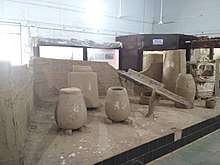
Main foods of Bhils are maize, onion, garlic and chili which they cultivate in their small fields. They collect fruits and vegetables from the local forests. Wheat and rice are used at time of festivals and other special occasions only. They keep self-made bows and arrows, swords, knives, axes etc with them as weapons for self-defense and hunting the wild fauna which also form the major part of their diet. They profusely use alcohol distilled by them from the flower of Mahua (Madhuca longifolia). On festive occasions, various special preparation from the dish rich, i.e. maize, wheat, barley, malt and rice. Bhils are traditionally non-vegetarian.[17]
Dress
The traditional dresses of men are Pagri, Angarkha, Dhoti and Gamchha. Traditionally women wear Sari and Ghagra Choli.
There are many traditional ornaments of Bhils. Men wear Kada, Bajuband, Chain, ear rings, Kardhani. Women wear variety of ornaments including hansli, ring, Zele-zumke, ear ring, narniyan(bangle), nathni(Nose-jewel) etc. Tattooing is traditional custom among them. Women folks do tattooing generally before marriage.[17]
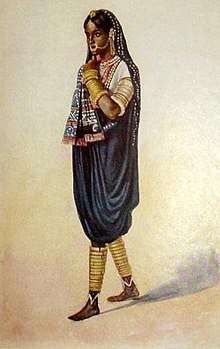
Faith and worship
Every village has its own local deity (Gramdev) and families too have their Jatidev, Kuldev and Kuldevi (house hold deity) which is symbolised by stones. 'Bhati dev' and 'Bhilat dev' are their serpent-god. 'Baba dev' is their village god. Karkulia dev is their crop god, Gopal dev is their pastoral god, Bag dev is their Lion god, Bhairav dev is their dog god. Some of their other gods are Indel dev, Bada dev, Mahadevel, Tejaji, Lotha mai, Techma, Orka Chichma and Kajal dev.
They have extreme and staunch faith in superstitious beliefs and Bhopas for their physical, mental and psychological treatments.[17]
Festivals
There are a number of festivals, viz. Rakhi, Navratri, Dashera, Diwali, Holi which are celebrated by the Bhils. They also celebrate some traditional festivals viz. Akhatij, Navmi, Howan Mata ki Chalavani, Sawan Mata ki jatar, Diwasa, Nawai, Bhagoria, Gal, Gar, Dhobi, Sanja, Indel, Doha etc. with ceremonious zeal and enthusiasm.
During some festivals there are a number of tribal fairs held at different places of districts. Navratri mela, Bhagoria mela(during Holi festival) etc.[17] Bhil community of Udaipur celebrate Gavari festival each year after Holi.[18]
Communal dance and festivities
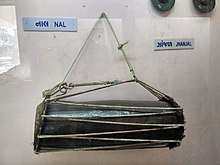
The chief means of their recreation is folk songs and dances. Women dance at birth celebrations, marriage functions t on a few festivals in traditional Bhili style accompanied by a drum beat. Their dances include the Lathi (staff) dance, Dhol dance, marriage dance, Holi dance, Battle dance, Bhagoria dance, Deepawal dance and hunting dance. Musical instruments include the Harmonium, Sarangi, Kundi, Bansuri, Apang, Khajria, Tabla, Jhanjh, Mandal and Thali. They are usually made from local products.[17]
Local political structure
Traditional Bhil villages are led by a headman (gameti). The gameti has authority and decision-making powers over most local disputes or issues.[19]
See also
References
Notes
Citations
- "A-11 Individual Scheduled Tribe Primary Census Abstract Data and its Appendix". Census of India 2011. Office of the Registrar General & Census Commissioner,used India. Retrieved 24 March 2017.
- "List of notified Scheduled Tribes" (PDF). Census India. Archived from the original (PDF) on 7 November 2013. Retrieved 15 December 2013.
- Statistical Profile of Scheduled Tribes in India (PDF). New Delhi: Ministry of Tribal Affairs. 2013. p. 10.
- Ghosh, S. K. (1987). Law Enforcement in Tribal Areas. Ashish Publishing House. p. 124. ISBN 9788170241003.
- Maheshwari, J. K.; Kalakoti, B. S.; Lal, Brij (1986). "Ethnomedicine of bhil tribe of jhabua district, m. P". Ancient Science of Life. 5 (4): 255–261. ISSN 0257-7941. PMC 3331472. PMID 22557535.
- "List of Scheduled Tribes". Census of India: Government of India. 7 March 2007. Archived from the original on 5 June 2010. Retrieved 27 November 2012.
- "Untitled Page" (PDF). www.tribal.mp.gov.in. Retrieved 14 April 2020.
- Administrator, Website (24 May 2015). "The Tribal Research & Development Institute Bhopal / List of scheduled tribes by the Commissioner of Tribal Development – Madhya Pradesh". Tribal Cultural Heritage in India Foundation. Retrieved 14 April 2020.
- Mehta, Sonu (2004). "Bhils - I". In Mehta, Prakash Chandra (ed.). Ethnographic Atlas of Indian Tribes. New Delhi: Discovery Publishing House. p. 191. ISBN 9788171418527.
- Phillips, Maxwell P. (2012). Dialect Continuum in the Bhil Tribal Belt: Grammatical Aspects (phd). University of London. p. 23.
- Ratnagar, Shereen (2010). Being Tribal. Delhi: Primus Books. ISBN 9789380607023.
- "Paper No. I - Languages". Census of India 1951. 1954. pp. 61.
- Pachauri, Swasti (26 June 2014). "Pithora art depicts different hues of tribal life". Indian Express. Retrieved 13 February 2015.
- Kumar, Ashok Kiran (2014). Inquisitive Social Sciences. Republic of India: S. Chand Publishing. p. 93. ISBN 9789352831098.
- Danver, Steven L. (28 June 2014). Native People of The World. United States of America: Routledge. p. 522. ISBN 978-0765682949.
- "Bhil Art - How A Tribe Uses Dots To Make Their Story Come Alive". Artisera. Retrieved 18 March 2019.
- Singh, V. P.; Jadhav, Dinesh (January 2011). Ethnobotany of Bhil Tribe. ISBN 9789387307360.
- "GAVARI: A tribal dance drama by the Bhil community of Udaipur". mediaindia.eu. Retrieved 4 September 2019.
- Winston, Robert, ed. (2004). Human: The Definitive Visual Guide. New York: Dorling Kindersley. p. 439. ISBN 0-7566-0520-2.
Further reading
- Shah, Arvind M. (2012). The Structure of Indian Society: Then and Now. Routledge. ISBN 978-1-13619-770-3.
External links
| Wikimedia Commons has media related to Bhil people. |
